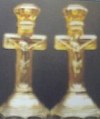Carnival Glass 101 | home Quick Reference to Carnival Glass Patterns on This Site
Dugan - Diamond Designs
DUGAN - DIAMOND Designs
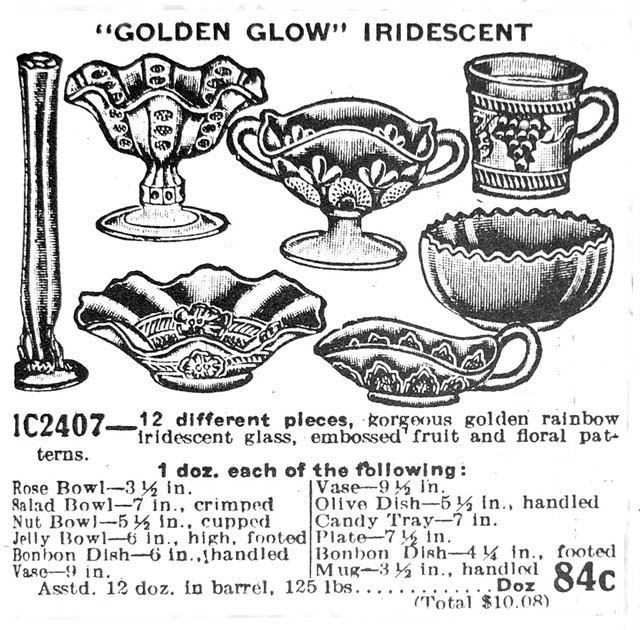
DUGAN-DIAMOND April 1929 Butler Bros. Ad.
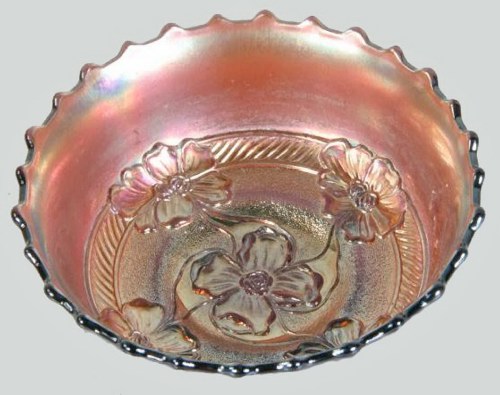
APPLE BLOSSOM is very difficult to locate in Amethyst.
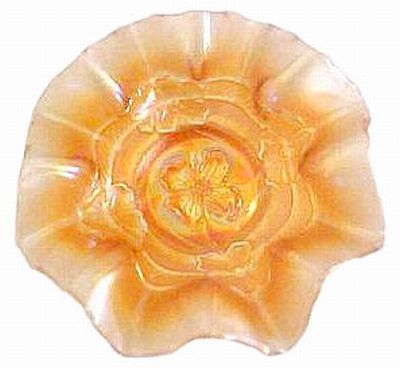
APPLE BLOSSOM 7.5 in. Bowl.
APPLE BLOSSOM: This design dates from the late carnival production era, appearing in the wholesale catalogs during the last few years of Diamond's production: 1928-1931. Many examples exhibit light to weak iridescence, which is typical of many late efforts by Diamond. However, some examples are beautifully iridized. Small round or variously ruffled 6”-7” bowls in marigold are available, with amethyst examples somewhat more difficult to locate. At least one deep, round cobalt blue bowl is known. White bowls are quite scarce. A few green examples are known, but green is a very rare color from this firm. Peach Opal? We have not seen one.
Although there are written references to “plate specimens” in this pattern, we have not seen any during our more than forty years of collecting, nor is there one on record as having sold at carnival glass auctions of note. A marigold, collar-based rose bowl, shaped from the bowl mold exists.
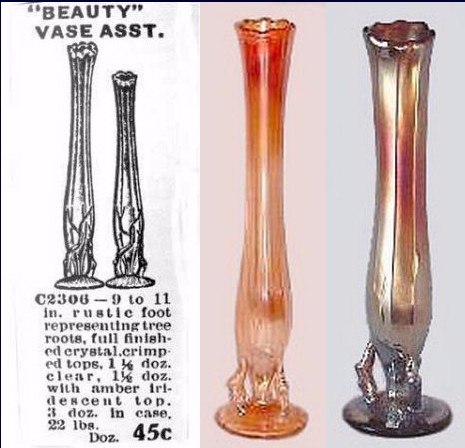
1916 Butler Brothers Ad for Beauty Bud Vases.
Two Beauty Bud vases - Marigold and Amethyst.
BEAUTY BUD VASE: This was a fixture in the wholesale catalogs from its initial appearance in 1916 up until the Diamond factory closed after the fire in 1931. The lengthy production and popular buying response created such an abundance of these vases that nearly any mall or antique shop today will provide at least a marigold example. Amethyst vases are quite difficult to find though.
Standing from an average of 7” to 9” tall, they are more erect than their cousins, the TWIGS vases, which are much shorter in stature. The base diameter is somewhat larger, as well.
Many of the marigold examples in this Beauty Bud vase have faded or weak color in the lower half portions. This is explained in the Butler Bros. Ad shown here. Notice the statement about {clear with amber iridescent tops}? They were manufactured with that appearance! Accordingly, they are usually quite reasonably priced. However, if you should find a nice amethyst vase in this pattern, the selling price sometimes will be 10 times the price of a marigold.
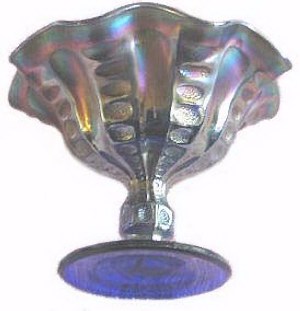
COIN SPOT Compote in Cobalt Blue!
COIN SPOT Compote: This compote pattern spanned both the Dugan and Diamond years of production. A wide variety of carnival colors, such as marigold, amethyst, peach opalescent, cobalt blue, celeste blue, ice green-defined as a Diamond color used for Stretch Glass during the 1920s. Examples of Windflower, Adam's Rib, Pony bowls and these Coin Spot compotes are known in ice green.
A “goblet” shape referred to in some writings is an unruffled compote shape.
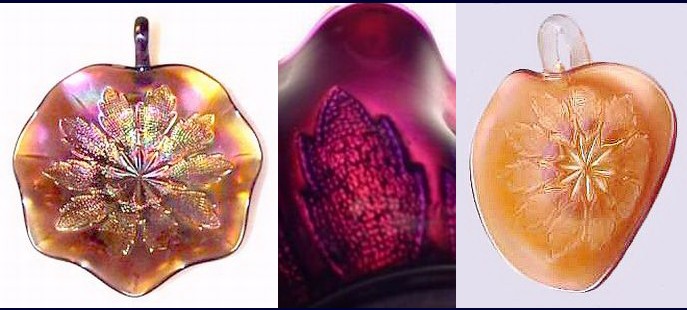
Left: Low Ruffled Leaf Ray Nappy in Amethyst.
Middle: Oxblood - a reddish amethyst.
Right: This Spade shape is the most common.
LEAF RAYS Nappy: Of all the patterns in carnival glass, this one is probably found more often than most others! This single-handled nappy spans a 19-year production run, first appearing in wholesale catalog ads in 1912, continuing into 1931. The only color which can be labeled scarce is cobalt blue. Spade shape in marigold, amethyst, white and peach opalescent are plentiful.
Ruffled nappies in a more rounded shape pose a more concentrated effort to locate. They are known in marigold, amethyst, and peach opalescent. Oxblood is a color referred to on occasion when describing an amethyst with a red-cast.
Leaf Rays can be found having no interior pattern. (Click here to view an example of a Absentee Leaf Rays Nappy) It was this basic mold design which was used to create the famous Elk nappy, an example of which can be seen by by clicking here.
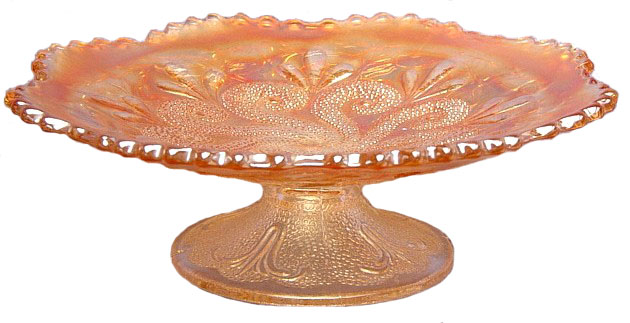
QUESTION MARKS Footed Plate with PUZZLE on the foot.
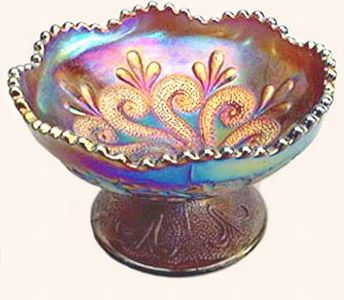
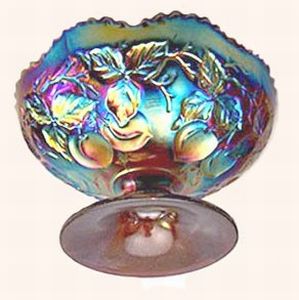
Left: QUESTION MARKS Compote
Right: GEORGIA BELLE exterior pattern.
QUESTION MARKS: Appears on stemmed, two-handled bonbons, having a plain exterior, in colors of marigold, amethyst, cobalt blue, peach opalescent, ice green, lavender, lime green with marigold overlay (which may fall into the category of After Glow). Compotes are known in marigold, amethyst, white, and peach opalescent.
Stemmed plates in marigold, fashioned from the compote shape, should be considered fairly scarce. Amethyst is probably the next most elusive plate color, with white following closely behind. These are usually flattened to between 7”- 8”. As with the compotes, a pattern called Georgia Belle is found as an intaglio design on the exterior body of the pieces. Georgia Belle combines peaches and leaves for a very effective design. The pedestal foot carries another familiar Dugan pattern called Puzzle. For pattern collectors, this combination provides a delightful effect!
Bonbons are certainly found more often than either the compote or plate. Peach opalescent and white were introduced by Thomas Dugan and those colors are frequently found. The pattern very likely entered production around 1910, although it did not appear in any known issues of wholesale catalogs until the early 1920s, continuing right up until the Diamond Glass plant closed in 1931.
Dean & Diane Fry, 3/10
The wisdom that is from above is…….without hypocrisy. -----James 3:17


When there is a discrepancy between what we say and what we do, we create confusion in the minds of our “audience”.
A Christian who makes the greatest impact on the watching world, and who furthers the cause of Christ,
is one whose actions harmonize with his words.
As James spoke of the “wisdom that is from above”, he described it as “pure, then peaceable, gentle, willing to yield, full of mercy and good fruits, without partiality and without hypocrisy”(James 3:17)


We're writing a “gospel”, a chapter each day,
By the deeds that we do, by the words that we say;
Men read what we write, whether faithless or true---
Say, what is the “gospel” according to you?
When words and actions agree, the message reads loud and clear.
Should you care to contact the Frys, their email address is:
Search Carnival Glass 101
back to Carnival Glass 101
Our other sites you may enjoy:
Everything you EVER wanted to know about Indiana Glass
Great Reference for Newer Carnival Glass.
Complete Glassware Catalogs Available to Download
Questions? Comments? Suggestions? Broken Links? Corrections?
Your Friendly Webmaster is here to help!
